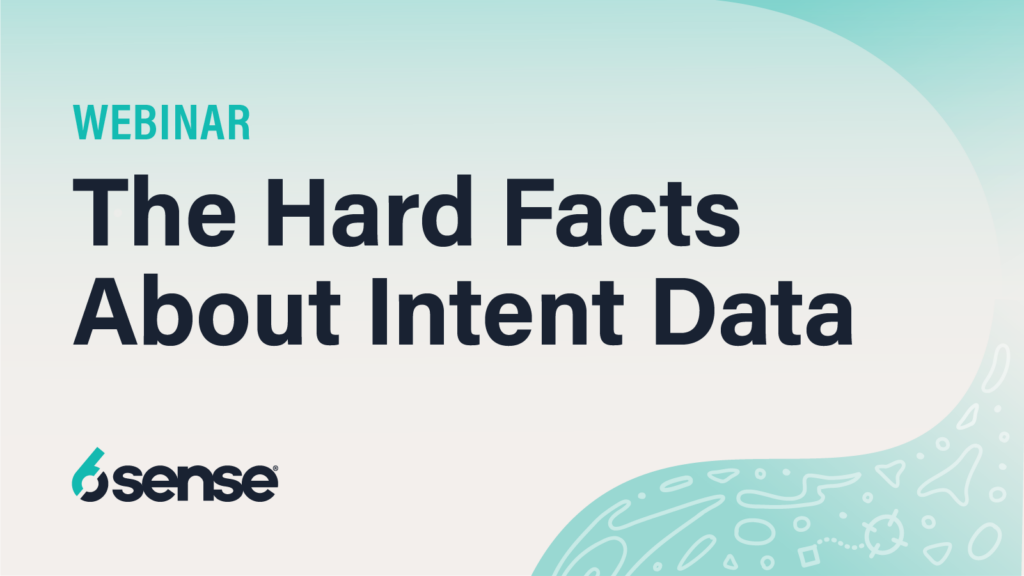For years, analysts and other marketing experts have been advising B2B marketers to minimize the number of forms they ask their web visitors to fill out. But the advice is not without its critics, led by the army of marketers who get paid to produce form-fills (aka, leads).
After all, if your job is to create demand (or at least, get your share of whatever is out there), how can you know the demand exists if folks don’t fill out a form when they drop by?
It used to be a reasonable question.
It is not anymore.
These days, we can de-anonymize a lot of web traffic to understand where your demand is coming from. The form isn’t as necessary. We can see where half or more of the traffic from prospect accounts is coming from. And in case you’re tempted to think, “only half?”, consider that if you rely on form fills, those form fills make up less than 20% of the meaningful visitors to your website (more detail on that is coming up just below).
De-anonymizing half of your anonymous web traffic triples what you know about which accounts are showing interest. And, as we will see, it also allows you to prioritize both marketing and sales resources more effectively.
But If Nobody Fills Out a Form, Who Will We Call and Email?
There’s still another serious objection to going formless: if no one fills out a form, isn’t that going to make life very hard on our sellers?
The answer is ‘not really,’ but it takes a bit of explaining to get there, and we need to knock off a couple really important issues around gating first.
Buyers Do Their Deciding Prior To Talking to Sales
In 84% of cases, buyersi make their decisions prior to talking to sellers and they don’t talk to sellers until they are 70% of the way through their buying journey. Buyers are going to form very strong and fixed opinions about you and your competitors based on what they learn without talking to you.
So, buyers need to be presented with all the content they’ll need to help them choose you before talking with representatives from your company. The providers that do the best job of enabling their buyers with content that addresses their information needs are going to have a meaningful competitive advantage, all else being equal.
Also, buyers really do not want to fill out forms.
Our research from last year showed that only 3% of all web visitors fill out forms. PathFactory found that about 15% to 20% of visitors from identifiable accounts filled out formsii. And most recently, we found that barely over 30% of buying group members filled out a form with a company they actually bought from.
If you gate, you will decrease the amount of information available to the 70% or more of your target audience of buying group members who are not going to fill out your forms.
Further, the content that marketers are most likely to gate is their ‘high value’ content. High value will mean different things to different marketers, but we can safely generalize it to mean content the marketer thinks is important and will be of interest to a buyer.
Gating will simply reduce the reach and impact of that high-value content.
Form-fill Leads Are Largely a Waste of Time
Still, it is reasonable to argue that without the form, you won’t have names for outreach.
Here are some things that we know that minimize the pain of going gateless.
First, we know from our research that when buyers engage with sellers, they do so at a time of their choosing. Buyers told us that they initiate that first contact with sellers 83% of the time. What that tells us is that even if they must fill out a form to get content, you are not going to get anywhere by calling or emailing before they are ready. Your SDR and seller teams will be wasting their time trying to get meetings. When the buyer is ready for a meeting, they will initiate contact.
At this point you may think, “Yes, but at least we will have their names, and if we call, they’ll know we’re interested in their business. Maybe they’ll even respond early because we’re being persistent.”
Here again, our data suggests otherwise. Granted, you’ll have their names, but there are two problems with this approach.
Content-Gated Leads Are Not What We’ve Been Taught
First, when you put content behind forms, it is not just people from in-market accounts who fill them out. The math gets complex, but the logic is solid. It starts with the fact that probably fewer than 10% of the accounts in your addressable market are in-market at any given time.
We don’t know how many people who fill out forms are or are not in-market. But, if you have compelling content and do a good job of SEO, it is likely that many if not most of the form-fills you receive will be from the 90% of companies and contacts that are potential future buyers but not in-market when they visit your website.
Unfortunately, most content-gating form-fills are hard to tell apart. Two people with the same job roles at similar companies will look at the same content. One is doing so out of professional curiosity, while the other is actively evaluating vendors. Your lead scoring cannot tell the merely curious from the in-market.
As a result, your SDRs and sales teams will be chasing them all. The in-market won’t respond until they’re ready. And then, if your content has done a good job, they’ll contact you. The merely curious will never respondiii.
SDR Lead-Pursuit May Have Negative Consequences
Second, there is evidence that poorly timed persistence may hurt, rather than help, your chances. In our recent study, we asked whether buyers initiated contact first with the ultimate winner or with another vendor. And, of course, we asked when that contact took place. If contact was with the winner first (this happened 84% of the time), it happened at 70% through the journey. If a buyer’s first live interaction was not the winner, it happened earlier — just 61% of the way through the journey.
Simply put: if buyers end up talking to vendor representatives prior to 70% of the way through the journey, it’s probably NOT with the winning vendor. Getting a prospect to respond before they’re ready does not improve your odds of winning.
So, back to the question: Isn’t reducing gating and form-fills going to make life harder on SDRS and sales? I hope by now you’ve grokked that by presenting our sellers with endless leads from individuals who are not part of active buying groups, or who are but who are not ready to talk, we have already made the lives of SDRs and sellers very hard. By prioritizing the accounts and leads they work, we help them be substantially more productive.
The Modern Approach to Prioritizing Prospects for Sales
The modern best-practice is to use third-party intent combined with de-anonymized web traffic to identify accounts that are truly in-market and showing interest.
If you don’t have form-fills from those accounts yet, use personalized, high value offers as described in the next section to encourage deeper engagement and self-identification. Acquire contacts to fill in gaps.
Where you have leads from in-market accounts, these leads are substantially more likely to be a good use of seller time. Be sure to always reach out to multiple contacts at any in-market account before giving up.
And of course, when individuals request contact from sales, or request demos or trials, those should be prioritized for contact, irrespective of in-market status.
All other leads — the leads from accounts that are not in market — can be safely ignored by sellers until there is more evidence that their accounts are in-market. The individuals behind those form-fills will be grateful to be left alone.
Does Anything Get a Gate?
Yes.
When you are using intent and anonymous traffic to identify in-market accounts, you can use that intelligence to put truly compelling offers in front of visitors from high-value, buying-mode accounts. These offers should be for gifts, experiences and other offers that encourage live engagement.
But that live engagement shouldn’t just be a sales meeting. Instead, think about experiences that enable potential buyers to network with their peers and your existing customers, or engage with subject-matter experts — experiences that provide value to your potential buyers. And of course, offerings such as product demos and trials require that buyers self-identify.
Summing Up
The great gate debate has been decided: ungate. That is the best way to ensure you are competitive during the critical period of the buying journey where buyers are deciding what they want through digital research and their networks. And remember that ungating shouldn’t happen in a vacuum. You also need to start capitalizing on all the anonymous signals your website will be producing.






